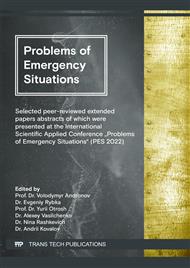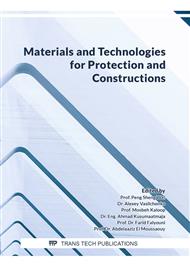[1]
S.S. Kaprielov, G.S. Kardumyan, Novye modificirovannye betony v sovremennyh sooruzheniyah, Beton i zhelezobeton. 2 (2011) 78–82.
Google Scholar
[2]
S.S. Kaprielov, A.V Shejnfeld., G.S., Kardumyan Novye modificirovannye betony, Moscow, (2010).
Google Scholar
[3]
A.V. Frolov, L.I. Chumadova, A.V. Cherkashin, L.I. Akimov, Ekonomichnost ispolzovaniya i vliyanie nanorazmernyh chastic na svojstva legkih vysokoprochnyh betonov. Stroitelstvo unikalnyh zdanij i sooruzhenij. 19 (2014) 51–61.
Google Scholar
[4]
A.D. Tolstoj, B.C. Lesovik, JI.X. Zagorodnyuk, I.A. Kovaleva, Poroshkovye betony s primeneniem tehnogennogo syrya, Vestnik MGSU, 1 (2015) 101–109.
DOI: 10.22227/1997-0935.2015.11.101-109
Google Scholar
[5]
V.P. Sopov, A.L. Tkachuk, Vliyanie mineralnyh dobavok na strukturoobrazovanie cementnogo kamnya. Naukovij visnik budivnictva. 66 (2011) 250–254.
Google Scholar
[6]
M.N Moroz., V.I Kalashnikov., V.A. Hudyakov, P.G. Vasilik , Vodostojkij melkozernistyj beton, gidrofobizirovannyj nanochasticami stearata kalciya. Stroitelnye materialy, 8 (2009) 55–59.
Google Scholar
[7]
A.V. Nomoev, V.C. Lygdenov, L.A. Urhanova, S.A. Lhasaranov, Melkozernistyj cementnyj beton s nanodispersnym modifikatorom. Nanotehnologii v stroitelstve: nauchnyj internet-zhurnal, 4 (2010) 42-52.
Google Scholar
[8]
A.I. Hristoforov, I.A. Hristoforova, D.I. Kuzmin, Melkozernistyj beton, modificirovannyj organicheskimi soedineniyami Na+. Stroitelstvo i rekonstrukciya, 2 (2011) 104–109.
Google Scholar
[9]
O.O. Shishkina, O.O. Shishkin Research on the injection of nanocatalyse into the molding of the plasticity of reaction powder concrete. Eastern European Journal of Advanced Technologies. 1/6(79). (2016) 55–60.
Google Scholar
[10]
A. Shishkina, A. Shishkin Study of the effect of micellar catalysis on the strength of alkaline reactive powder concrete. Eastern-European Journal of Enteprise Technologies.3/6 (93). (2018) 46–51.
DOI: 10.15587/1729-4061.2018.133445
Google Scholar
[11]
А Shyshkina, A.Shyshkin Fine-Grained Concrete for Repair and Restoration of Building Structures Materials Science Forum Submitted. 1038, (2021) 317-322. Trans Tech Publications Ltd, Switzerland.
DOI: 10.4028/www.scientific.net/msf.1038.317
Google Scholar
[12]
A. Shishkina А. Shishkin Application of the easy concentration effect in concrete technology.Innovative Technology in Architecture and Design (ITAD 2020). IOP Conf. Series: Materials Science and Engineering (2020) 907 012038.
DOI: 10.1088/1757-899x/907/1/012038
Google Scholar
[13]
N. S. Gurinenko. Technology, hardening kinetics, strength and properties of heavy concrete with a multifunctional complex additive. Problems of modern concrete and reinforced concrete 11. (2019) 125–146.
Google Scholar
[14]
Information onhttp://www.itp.nsc.ru/conferences/mzhz_2015/files/S06_Titov2.pdf.
Google Scholar



